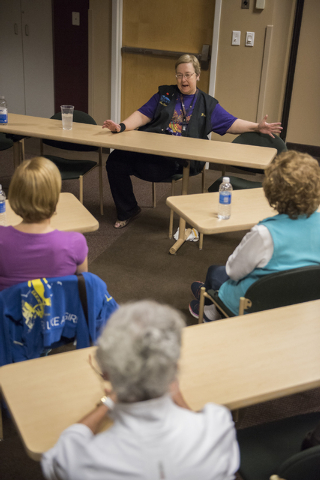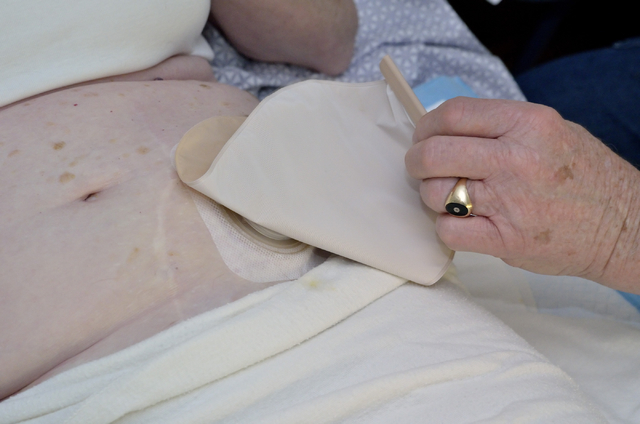Ostmate support groups filled with stories of past successes, hopes for future
As they discuss past successes, present challenges and their hopes for the future, the folks sharing experiences and emotional support could be members of a church or PTA group, not people with a life-changing health care condition.
“Throughout my life, in all the places we’ve lived, we’ve joined ostomy support groups,” said Carol Cox, 69, whose ileostomy, an opening in the belly to remove waste, was created in 1967. “The helpful hints and tricks of the trade shared at the meetings, they’re just so informative.”
Ostomy support groups at St. Rose Siena and Sunrise hospitals help people who have had a surgical procedure creating an opening in the body for the discharge of bodily wastes. Starting a third group to serve people in the northern end of the Las Vegas Valley also is being explored.
Studies have shown the benefits of belonging to mutual support groups for several health care challenges. Patient support groups in Southern Nevada help diabetics manage their blood sugar, burn victims adjust to their new appearance and people dealing with cancer face their own mortality.
Ostomy pouches on the abdomen collect urine or feces, and the bags can fit comfortably under clothing you can buy off the rack. But people who have ostomies — known as ostomates — often encounter a lack of understanding, and their loved ones can be the source of the stigma. For some patients, living with an ostomy can mean hesitancy and doubts about leaving home, and many ostomates are too self-conscious to share their condition even with close friends.
Specially trained nurses help the estimated 75,000 patients each year who have ostomies surgically created to relieve intestinal diseases or prostate, bladder, colorectal and gynecologic cancers. Without proper treatment and rehabilitation after surgery, patients can be demoralized and in some cases incapacitated.
“For new patients learning how the pouch goes on, it’s only three steps, but in their mind, it’s like building the Empire State Building,” said Brenda Leake, an enterostomal therapist nurse practitioner at Sunrise. “It can be a tremendous process for some patients to get to the point where they can be on their own and direct other people to help them.”
Corinne Rhodes calls the period before she received her ostomy four years of hell. She was in the eighth grade when she was diagnosed with Crohn’s disease, an inflammatory bowel disorder, resulting in swelling and dysfunction of the intestinal tract. Throughout her high school years, she was tormented with nausea, pain, cramping and diarrhea.
When she was told about the planned surgery in 1984, at first she felt scared.
“As scary as it was to go through that operation, it gave me my life back,” said the 49-year-old speech and language specialist at McCaw Elementary School in Henderson.
Cox, who moved to Henderson with husband Kim in 2006, had surgery in June 1967, a year filled with struggle and pain for the retired longtime school support staffer. Months after giving birth to her daughter, she had dropped to 72 pounds from ulcerative colitis, a gastrointestinal disease that causes swelling, ulcerations and loss of function of the large intestine.
After the surgery, she was so compromised that her family had gathered, and she worried she would not pull through. All of her loved ones were with her except her first husband, who was serving in the Vietnam War. In October of that year, her husband was killed without ever meeting his daughter or seeing how his wife had triumphed over her bowel disorder. Two years later, she met her current husband, and the couple have been together ever since.
In the support groups, Cox and Rhodes can share their years of experiences and listen to the practical advice of others. Ostomy patients can take up to two years to accept and adapt fully to their new condition, according to the United Ostomy Associations of America. Fran Popp, a technical analysis specialist with Dignity Health Nevada and secretary of the UOAA, chairs the meetings at Siena on the second Saturday each month. The group at Sunrise meets on the second Tuesday of the month.
Cathy Downey, a certified wound, ostomy and continence nurse who works at University Medical Center, often is on hand at either meeting to answer questions and dispel misconceptions about living with an ostomy. Ostomates can lead active, normal lives once they recuperate from surgery and learn how to care for their stoma, the surgically constructed opening in the abdominal wall that permits the passage of waste. Ostomates can travel, exercise, wear regular clothes and eat a normal diet.
Sexual activity can be fulfilling with an accepting and loving partner, and a woman’s ability to conceive a child does not change. Pregnancy and delivery should be normal after ostomy surgery, but before getting pregnant, a woman should consult a doctor about any other health problems.
Each summer, the national organization puts on a weeklong camp for 11- to 17-year-olds with bowel or bladder issues, giving youth an opportunity to share and learn the life-changing experiences they have had. Part of the proceeds from the 14th Annual Hugs and Hearts for Charity by the Summerlin Lions Club on Feb. 21 will be used to sponsor a child to attend the camp, Downey said.
Sometimes, even nurses can complicate the situation if they have negative attitudes about ostomies. Cox says nurses often act relieved when they discover her husband is competent to participate in her ostomy care.
Leake educates health care professionals to be cognizant about facial expressions, tone of voice and body language when caring for ostomy patients. Patients pick up on nonverbal cues and can sense discomfort in their caregivers, she said.
Patients today have advantages because ostomy products have evolved to provide more comfort, security and sanitation with odor barriers, filters and deodorizing vents that can neutralize the gas coming out of the pouch and keep it from ballooning. A representative from Coloplast, a manufacturer of ostomy products based in Minneapolis, will be at next month’s meeting at Sunrise to talk about the SenSura Mio, the company’s new pouch made from a textile to provide more flexibility for body movement.
“It feels like an accessory, not a medical device that patients have to wear every day,” Sonia McDonough, the Coloplast marketing director, said.
Such advances make things easier for patients than when Cox was sent home from the hospital nearly 50 years ago.
“It wasn’t like it is today,” Cox said. “Nobody told me about supplies or where to go. We had to figure that all out on our own.
“They didn’t send any information home with you.”
And the advances don’t make up for the challenges faced by someone trying to recover after such life-altering surgery, Leake said.
“If it’s an emergency surgery, and the patient wakes up to learn about the ostomy, no one is grateful initially. No one is happy about it. No one wants to look at it,” she said. “Patients today don’t realize how lucky they are, but they don’t feel lucky.”
For Ostomy support patients, please contact:
Website: ostomylasvegas.weebly.com
Email: snvostomy@gmail.com
Phone: 702-483-8116
National Website: ostomy.org









































